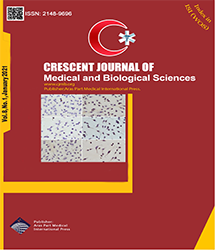
| Original Article | |
| Comparison of Intrapleural Bupivacaine Versus Bupivacaine Plus Ketamine on Post-Thoracoscopic Pain Control: A Randomized Clinical Trial | |
| Reza Movassaghi1, Abbasali Dehghani1, Samad Beheshtirouy2 | |
| 1Department of Anesthesiology, Medicine Faculty, Tabriz University of Medical Sciences Tabriz, Iran 2Department of Thoracic Surgery, Medicine Faculty, Tabriz University of Medical Sciences Tabriz, Iran |
|
|
CJMB 2021; 8: 061-066 Viewed : 4737 times Downloaded : 2232 times. Keywords : Bupivacaine, Ketamine, Postoperative, Pain, Thoracoscopy |
|
| Full Text(PDF) | Related Articles | |
| Abstract | |
Objectives: Considering the unwanted and undesirable side effects of opioid pain control after thoracoscopic surgery, the present study aimed to compare intrapleural bupivacaine vs. bupivacaine + ketamine on post-thoracoscopic pain control. Materials and Methods: This randomized clinical trial study was performed on 60 candidates for thoracoscopy in Imam Reza hospital (Tabriz-Iran) during 2014-2016. The intervention was started after the random allocation of patients into control and intervention groups each containing 30 people. Before the surgery, patients in the control group received bupivacaine and those in the intervention group received bupivacaine + ketamine through an intrapleural catheter. Then, pain intensity and a need for an opioid after the surgery were measured in two groups based on visual pain criteria. The results of the two groups were compared by paired t test, chi-square test, and Mann-Whitney test using SPSS 23. Results: Based on the results, the intensity of pain was significantly lower in the intervention group 6 (P = 0.032), 12 (P = 0.049), and 24 (P = 0.048) hours after the surgery compared with the control group, and the amount of the consumed pethidine in both groups showed that the average pethidine consumption in the intervention group was significantly lower compared to the control group in the first (P = 0.009), the second (P = 0.014), the third (P = 0.031), and the fourth (P = 0.02) six hours after the surgery. Conclusions: In general, intrapleural low-dose ketamine in combination with bupivacaine is effective in post-thoracoscopy pain control. |
Cite By, Google Scholar
Online Submission System
 CJMB ENDNOTE ® Style
CJMB ENDNOTE ® Style
 Tutorials
Tutorials
 Publication Charge
Medical and Biological Research Center
About Journal
Publication Charge
Medical and Biological Research Center
About Journal
Aras Part Medical International Press Editor-in-Chief
Arash Khaki
Deputy Editor
Zafer Akan


















